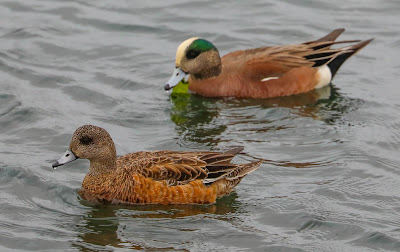I'd never seen an American wigeon before, didn't really know anything about them, not sure I'd ever really heard of them. Then one morning in January we took an early morning walk around a portion of the Batiquitous Lagoon in Carlsbad and we started seeing ducks that I did not recognize, in fact it looked like multiple species of ducks. Then we encountered a list of birds on a message board at the Lagoon which had a bird count for early January and noted that the American wigeon was by far the most plentiful bird seen so far. Judy plugged the name into her iPhone and the American wigeon was born into our memories.
I took lots of photos and got to know this particular species of duck better as I saw different variations through my many pictures. I've subsequently seen other American wigeons since that day, including some at Upper Newport Bay near Big Canyon (mixed with a few green-winged teals) and Bolsa Chica Conservation Area near Huntington Beach.
The American wigeon breeds in northern North America (Alaska, Canada and parts of the northern U.S.) and winters in much of the west and midwest of the U.S., Florida and small portions of the east coast, Mexico and a small portion of northern South America.
 |
| This series of photos were taken at Bolsa Chica. |
The breeding male has a very distinctive cream colored stripe running from the crown of its head to its bill. It has a green patch around its eye that then extends back to he base of its neck. A light bluish/gray bill with a black tip and grayish/brown feathers fill out the rest of the head, going down to a darker brown strip around its neck. The rest of the body is mostly chestnut brown, with a black trail, a white rump patch, a white belly patch and white and green patches on its wing usually not visible unless in flight.
The female has the same colored head and bill, but without the creamy stripe or green eye patch and stripe. Instead it has a dark smudge around its eye, like someone has punched it and given it a black eye. The rest of the body is mostly various shades of brown.
The head of a non-breeding male looks like a female's.







The name is so close to "pigeon," but they are clearly not related. I wonder where the name came from.
ReplyDelete